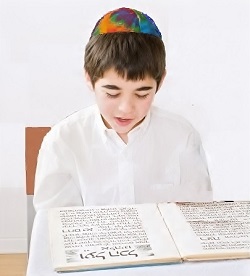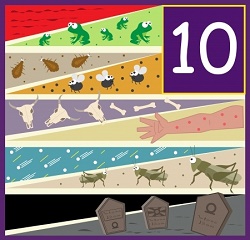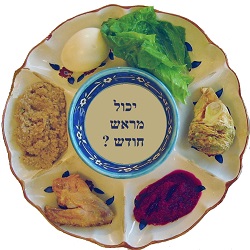 Edit article
Edit articleSeries
Some Biblical Perspectives on the Haggadah

Charlotte Rothschild Haggadah, Zürich, Braginsky Collection, B314, p. 42. CC
Although the Haggadah frequently quotes the Bible, there is no evidence in the Bible for a set text for the ritual retelling of the exodus until the Mishna and Tosefta – before the end of 2ndcentury C.E. Nevertheless, familiarity with the Bible, especially as reflected in the academic study of the Bible, helps solve at least three very well-known conundrums of the Haggadah.
The Wise Son

The key is realizing that the biblical text changed over time, and evenat the time that the earliest parts of the Haggadah were written, was not totally unified and in agreement with the Hebrew text that we now have. This is reflected in the pluriformity (the opposite of “uniformity”) of texts found among the Dead Sea Scrolls, and in the Septuagint, the Greek translation of the Bible begun in the third century BCE, which at points disagrees with our Hebrew text because it was translated from a different Hebrew text than the one that became standard in later Jewish tradition. (Indeed, there are many cases where the Dead Sea Scrolls have brought to light the Hebrew text that was likely used by the translators of the Septuagint.)
Many trees have been killed as many solutions have been offered for why the chacham, the wise son, and the rasha, the wicked son, offer nearly identical questions, but get such different answers. The rasha, the wicked son, asks, “מה העבודה הזאת לכם” “What do you mean by this rite?”—the question of Exodus 12:26 (JPS translation). The admonition of the Haggadah that you should bash his teeth in is based on the second person pronoun, “you”—he is excluding himself. This is all fine and good (if you believe in corporal punishment) until you return to the question of the chacham, the wise son, which is also in the second person, from Deuteronomy 6:20: “מה העדת והחקים ומשפטים אשר צוה י-הוה א-להינו אתכם” “What mean the decrees, laws, and rules that the LORD our God has enjoined upon you?” The wise excludes himself just as much as the wicked son—why then is he spared?
Unfortunately, no Dead Sea Scroll fragments of Deuteronomy 6:20 have survived, but many Septuagint manuscripts of that passage suggest a Hebrew text that read “What mean the decrees, laws, and rules that the Lord our God has enjoined upon us?” — otanu instead of etchem! This reading is probably the basis of the derashah, the exposition in the Haggadah—the difference between inclusion (otanu us) and exclusion (etchem them).
That is why the chacham is lauded—he includes himself in the community, while the rasha is punished. And indeed, some manuscripts of the Haggadah, including of Maimonides’ Haggadah, quote the wise son saying “us” rather than “them.”[1] This is a rare and remarkable case of a biblical variant to what became the standard Torah text surviving into the middle ages!
The Ten Plagues

Why is there so much emphasis on the number ten of the ten plagues in theHaggadah? Isn’t it obvious that there are ten plagues?
Not really. A careful look at the book of Exodus shows that the plagues are never enumerated—the number ten never appears there.[2] In fact, the Bible (to say nothing of post-biblical literature)[3] contains several traditions about the plagues, their number, and their order. Strikingly, Deuteronomy, in recalling Exodus, never enumerates them at all. They are recalled in several psalms, most especially 78 and 105. Psalm 105:27-36 reads:
(כז) שָֽׂמוּ בָ֭ם דִּבְרֵ֣י אֹתוֹתָ֑יו וּ֝מֹפְתִ֗ים בְּאֶ֣רֶץ חָֽם: (כח) שָׁ֣לַֽח חֹ֭שֶׁךְ וַיַּחְשִׁ֑ךְ וְלֹֽא מָ֝ר֗וּ אֶת דבריו דְּבָרֽוֹ: (כט) הָפַ֣ךְ אֶת מֵימֵיהֶ֣ם לְדָ֑ם וַ֝יָּ֗מֶת אֶת דְּגָתָֽם: (ל) שָׁרַ֣ץ אַרְצָ֣ם צְפַרְדְּעִ֑ים בְּ֝חַדְרֵ֗י מַלְכֵיהֶֽם: (לא) אָ֭מַר וַיָּבֹ֣א עָרֹ֑ב כִּ֝נִּ֗ים בְּכָל גְּבוּלָֽם: (לב) נָתַ֣ן גִּשְׁמֵיהֶ֣ם בָּרָ֑ד אֵ֖שׁ לֶהָב֣וֹת בְּאַרְצָֽם: (לג) וַיַּ֣ךְ גַּ֭פְנָם וּתְאֵנָתָ֑ם וַ֝יְשַׁבֵּ֗ר עֵ֣ץ גְּבוּלָֽם: (לד) אָ֭מַר וַיָּבֹ֣א אַרְבֶּ֑ה וְ֝יֶ֗לֶק וְאֵ֣ין מִסְפָּֽר: (לה) וַיֹּ֣אכַל כָּל עֵ֣שֶׂב בְּאַרְצָ֑ם וַ֝יֹּ֗אכַל פְּרִ֣י אַדְמָתָֽם: (לו) וַיַּ֣ךְ כָּל בְּכ֣וֹר בְּאַרְצָ֑ם רֵ֝אשִׁ֗ית לְכָל אוֹנָֽם:
27 They performed His signs among them, His wonders, against the land of Ham. 28 He sent darkness; it was very dark; did they not defy His word? 29 He turned their waters into blood and killed their fish. 30 Their land teemed with frogs, even the rooms of their king. 31 Swarms came at His command, lice, throughout their country. 32 He gave them hail for rain, and flaming fire in their land. 33 He struck their vines and fig trees, broke down the trees of their country. 34 Locusts came at His command, grasshoppers without number. 35 They devoured every green thing in the land; they consumed the produce of the soil. 36 He struck down every first-born in the land, the first fruit of their vigor. (NJPS slightly modified)
The first plague is darkness—the ninth plague of the Torah. Boils are nowhere to be found. And if we assume, following the rules of biblical poetry, that each verse describes a single plague, we would count them as: (1) darkness; (2) blood; (3) frogs; (4) a swarm of lice; (5) hail; (6) locusts; (7) death of the firstborn.
The rabbis of the Haggadah, in insisting on ten plagues, in the order of Exodus, may be showing their awareness of the tradition of seven plagues found here in Psalms (and a bit differently, in Psalm 78), and claiming that the Torah’s version, with ten plagues, is more definitive. A significant point of the rabbis is that even though the Bible is comprised of Torah, Nevi’im (Prophets) and Ketuvim (Writings), the Torah is its most important section—that is why they emphasize the Torah’s version of the plagues, as found in Exodus, in opposition to that found in Psalms.
But why does the number ten never appear in Exodus in relation to the plagues? Biblical scholars have shown that the plague narrative there is composite, comprised of two or three sources that have been melded together. None of these sources had all ten plagues. The redactor, who combined these sources together, is responsible for creating a story with ten plagues, but he was fundamentally conservative, and thus tended not to add to his earlier sources—he would not have inserted the number ten into his narrative. Thus, it was up to later sources to note and emphasize the ten plagues.
Passover at the Beginning of Nissan?
 The ambiguity concerning the date of Passover depends on the Hebrew word chodesh, which may be translated as “month” or “new moon.” More specifically, Exodus 23:15, 34:18 and Deuteronomy 16:1 insist that Pesach be commemorated in or on chodesh ha’aviv – but should this be translated as “the month of Aviv (budding [barley])” or “the new moon of Aviv”?
The ambiguity concerning the date of Passover depends on the Hebrew word chodesh, which may be translated as “month” or “new moon.” More specifically, Exodus 23:15, 34:18 and Deuteronomy 16:1 insist that Pesach be commemorated in or on chodesh ha’aviv – but should this be translated as “the month of Aviv (budding [barley])” or “the new moon of Aviv”?
The phrase mo‘ed chodesh ha’aviv in the two Exodus texts may well suggest the latter: It makes sense to speak of the appointed time at the new moon; it is less logical to speak of the appointed time in the month—why not just say the fourteenth of the month? Thus, these three texts may well preserve a tradition that at some point in ancient Israel, in some communities, Pesach was commemorated at the beginning of the month rather than at its middle. And thus, the Haggadah, is emphasizing that the festival begins on the fourteenth, as stated explicitly e.g. in Leviticus 23, and not the first of the month, as might be implied by Exodus and Deuteronomy.One of the strangest traditions in theHaggadah begins יכול מראש חודש, “you might think that it starts on rosh chodesh. But to what does the “it” refer?
I would like to suggest that this tradition recognizes the possibility that Passover starts on rosh chodesh, on the new moon or the first of Nissan. But Leviticus 23:5 explicitly notes: “In the first month, on the fourteenth day of the month, at twilight, there shall be a passover offering to the Lord.”[4] Nothing could be more clear about when the festival begins. How might anyone ever think that it began on the first?
Does this matter?
As a historian of religion, I believe that all religions change over time. As an observant Jew, this knowledge is enriching—it connects my current patterns of observance, largely constructed by the rabbis, to earlier biblical patterns.[5] Stated differently, I am not about to celebrate Pesach on the first on Nissan, by a recitation of the seven plagues, using a Haggadah text that is based on the Septuagint.
But understanding all of these features that modern academic biblical scholarship has raised—that there was a period when there was no single Torah text, that Psalms might disagree with the Torah, that the Torah text of the ten plagues is composite, and that festivals may have once been celebrated differently, even at different times—helps me enjoy Pesach more now, even if I believe that I am not commemorating it exactly as my earliest ancestors did.
TheTorah.com is a 501(c)(3) nonprofit organization.
We rely on the support of readers like you. Please support us.
Published
April 7, 2014
|
Last Updated
April 14, 2024
Previous in the Series
Next in the Series
Footnotes

Prof. Marc Zvi Brettler is Bernice & Morton Lerner Distinguished Professor of Judaic Studies at Duke University, and Dora Golding Professor of Biblical Studies (Emeritus) at Brandeis University. He is author of many books and articles, including How to Read the Jewish Bible (also published in Hebrew), co-editor of The Jewish Study Bible and The Jewish Annotated New Testament (with Amy-Jill Levine), and co-author of The Bible and the Believer (with Peter Enns and Daniel J. Harrington), and The Bible With and Without Jesus: How Jews and Christians Read the Same Stories Differently (with Amy-Jill Levine). Brettler is a cofounder of TheTorah.com.
Essays on Related Topics:





